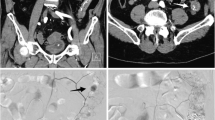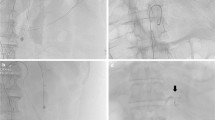Abstract
Background
Gastrointestinal and abdominal bleeding can lead to life-threatening situations. Embolization is considered a feasible and safe treatment option. The relevance of surgery has thus diminished in the past. The aim of the present study was to evaluate the role of surgery in the management of patients after embolization.
Methods
We performed a retrospective single-center analysis of outcomes after transarterial embolization of acute abdominal and gastrointestinal hemorrhage between January 2009 and December 2012 at the Sisters of Charity Hospital, Linz. Patients were divided into three groups, as follows: upper gastrointestinal bleeding (UGIB), lower gastrointestinal bleeding (LGIB), and abdominal hemorrhage.
Results
Fifty-four patients with 55 bleeding events were included. The bleeding source could be localized angiographically in 80 %, and the primary clinical success rate of embolization was 81.8 % (45/55 cases). Early recurrent bleeding (<30 days) occurred in 18.2 % (10/55) of the patients, and delayed recurrent hemorrhage (>30 days) developed in 3.6 % (2/55). The mean follow-up was 8.4 months, and data were available for 85.2 % (46/54) of the patients. Surgery after embolization was required in 20.4 % of these patients (11/54). Failure to localize the bleeding site was identified as predictive of recurrent bleeding (p = 0.009). More than one embolization effort increased the risk of complications (p = 0.02) and rebleeding (p = 0.07).
Conclusions
Surgery still has an important role after embolization in patients with gastrointestinal and abdominal hemorrhage. One of five patients required surgery in cases of early and delayed rebleeding or because of ischemic complications (2/55 both had ischemic damage of the gallbladder) and bleeding consequences.






Similar content being viewed by others
References
Sam C, Massaro JM, D’Agostino RB Sr et al (2004) Warfarin and aspirin use and the predictors of major bleeding complications in atrial fibrillation (the Framingham heart study). Am J Cardiol 94:947–951
Higham J, Kang JYMA (2002) Recent trends in admission and mortality due to peptic ulcer in England. Increasing frequency of haemorrhage among older subjects. Gut 50:460–464
Derry S, Loke JK (2000) Risk of gastrointestinal haemorrhage with long term use of aspirin: meta-analysis. BMJ 321:1183–1187
van Leerdam ME, Vreeburg EM, Rauws EA et al (2003) Acute upper GI bleeding: did anything change? Time trend analysis of incidence and outcome of acute upper GI bleeding between 1993/1994 and 2000. Am J Gastroenetrol 98:1494–1499
Blatchford O, Davidson LA, Murray WR et al (1997) Acute upper gastrointestinal hemorrhage in west of Scotland: case ascertainment study. BMJ 315(7107):510–514
van Leerdam ME (2008) Epidemiology of acute upper gastrointestinal bleeding. Best Pract Res Clin Gastroenterol 22:209–224
Longstreth GF (1997) Epidemiology and outcome of patients hospitalized with acute lower gastrointestinal hemorrhage: a population-based study. Am J Gastroenterol 92:419–424
Di Fiore F, Lecleire S, Merle V et al (2005) Changes in characteristics and outcome of acute upper gastrointestinal haemorrhage: a comparison of epidemiology and practices between 1996 and 2000 in a multicenter French study. Eur J Gastroenterol Hepatol 17:641–647
Walker TG, Salazar GM, Waltman AC (2012) Angiographic evaluation and management of acute gastrointestinal hemorrhage. World J Gastroenterol 18:1191–1201
Mirsadraee S, Tirukonda P, Nicholson A et al (2011) Embolization for non variceal upper gastrointestinal tract haemorrhage: a systematic review. Clin Radiol 66:500–509
Bulut OB, Rasmussen C, Fischer A (1996) Acute surgical treatment of complicated peptic ulcers with special reference to the elderly. World J Surg 20:574–577. doi:10.1007/s002689900089
Hermansson M, Stael von Holstein C, Zilling T (1997) Peptic ulcer perforation before and after the introduction of H2-receptor blockers and proton pump inhibitors. Scand J Gastroenterol 32:523–529
Becker HD, Schriefers KH (1987) Operative treatment of gastric and duodenal hemorrhage. Surgery of the stomach. Indications, methods, complications. Springer, New York, pp 275–281
Farrell JJ, Friedmann LS (2005) The management of lower gastrointestinal bleeding. Aliment Pharamcol Ther 21:1281–1298
Foitzik T, Klar E (1996) Vaskuläre Notfälle des Darmes. In Winkeltau GJ, Lerch MM, (Hrsg) Gastroenterologische Notfalltherapie, Stuttgart, Wiss Verlag Ges, S, pp 239–247
Jensen DM, Machiado GA, Juthaba R et al (2000) Urgent colonoscopy for the diagnosis and treatment of severe diverticular hemorrhage. N Engl J Med 342:78–82
Lhewa DY, Strate LL (2012) Pros and cons of colonoscopy in management of lower gastrointestinal bleeding. World J Gastroenterol 18:1185–1190
Geffroy Y, Rodallec MH, Boulay-Coletta I et al (2011) Multidetector CT angiography in acute gastrointestinal bleeding: why, when, and how. M Radiographics 31:E35–E46
Barnert J, Messmann H (2009) Diagnosis and management of lower gastrointestinal bleeding. Nat Rev Gastroenterol Hepatol 6:637–646
Boudghene F, L’Hermine C, Bigot JM (1993) Arterial complications of pancreatitis: diagnosis and therapeutic aspects in 104 cases. J Vasc Interv Radiol 4:551–558
Jaideep U, Barge MD, Jorge E et al (2012) Vascular complications of pancreatitis: role of interventional therapy. Korean J Radiol 13:45–55
Knoefel WT, Hosch SB, Peiper M (2004) Chronic pancreatitis—from losing heart to acting smart! Eur J Med Res 9:563–564
Dousset B, Sauvanet A, Bardou M (1997) Selective surgical indications for iatrogenic hemobilia. Surgery 121:37–41
Pongchairerks P (1993) Ultrasound-guided liver biopsy: accuracy, safety and sonographic findings. J Med Assoc Thai 76:597–600
Rudich SM, Kinkhabwal MM, Murray NG (1998) Successful treatment of mycotic hepatic artery pseudoaneurysms with arterial reconstruction and liposomal amphotericin B. Liver Transpl Surg 4:91–93
Yap FY, Omene BO, Patel MN (2013) Transcatheter embolotherapy for gastrointestinal bleeding: a single center review of safety, efficacy, and clinical outcomes. Dis Sci 58:1976–1984
Loffroy R, Estivalet L, Cherblanc V et al (2012) Transcatheter embolotherapy for gastrointestinal bleeding: a single center review of safety, efficacy, and clinical outcomes. World J Gastrointest Surg 4:223–227
Loffroy R (2013) Transcatheter embolization as the new reference standard for endoscopically unmanageable upper gastrointestinal bleeding. Management of duodenal ulcer bleeding resistant to endoscopy: surgery is dead! World J Gastroenterol 19:1150–1151
Koh DC, Luchtefeld MA, Kim DG (2009) Efficacy of transarterial embolization as definitive treatment in lower gastrointestinal bleeding. BR Colorectal Dis 11:53–59
Bardou M, Benhaberou-Brun D, Le Ray I (2012) Diagnosis and management of nonvariceal upper gastrointestinal bleeding. Nat Rev Gastroenterol Hepatol 9:97–104
Lee L, Iqbal S, Najmeh S et al (2012) Mesenteric angiography for acute gastrointestinal bleed; predictors of active extravasation and outcomes. Can J Surg 55:382–388
Eriksson LG, Ljungdahl M, Sundbom M et al (2008) Transcatheter arterial embolization versus surgery in the treatment of upper gastrointestinal bleeding after therapeutic endoscopy failure. J Vasc Interv Radiol 19:1413–1418
Venclauskas L, Bratlie SO, Zachrisson K et al (2010) Is transcatheter arterial embolization a safer alternative than surgery when endoscopic therapy fails in bleeding duodenal ulcer? Scand J Gastroenterol 45:299–304
Defreyne L, Vanlangenhove P, De Vos M et al (2001) Embolization as a first approach with endoscopically unmanageable acute nonvariceal gastrointestinal hemorrhage. Radiology 218:739–748
Funaki B, Kostelic JK, Lorenz J et al (2001) Superselective microcoil embolization of colonic hemorrhage. AJR 177:829
Gillespie CJ, Sutherland AD, Mossop PJ et al (2010) Mesenteric embolization for lower gastrointestinal bleeding. Dis Colon Rectum 53:1258–1264
Tan KK, Wong D, Sim R (2008) Superselective embolization for lower gastrointestinal hemorrhage: an institutional review over 7 years. World J Surg 32:2707–2715. doi:10.1007/s00268-008-9759-6
Lipof T, Sardella WV, Bartus CM et al (2008) The efficacy and durability of super-selective embolization in the treatment of lower gastrointestinal bleeding. Dis Colon Rectum 51:301–305
Kickuth R, Rattunde H, Gschossmann J et al (2008) Acute lower gastrointestinal hemorrhage: minimally invasive management with microcatheter embolization. J Vasc Interv Radiol 19:1289–1296
Teng HC, Liang HL, Lin YH et al (2013) The efficacy and long-term outcome of microcoil embolotherapy for acute lower gastrointestinal bleeding. Korean J Radiol 14:259–268
Ahmed TM, Cowley JB, Robinson G et al (2010) Long term follow-up of transcatheter coil embolotherapy for major colonic haemorrhage. Colorectal Dis 12:1013–1017
Maleux G, Roeflaer F, Heye S et al (2009) Long-term outcome of transcatheter embolotherapy for acute lower gastrointestinal hemorrhage. Am J Gastroenterol 104:2042–2046
Yi WS, Vegeler R, Hoang K et al (2012) Watch and wait: conservative management of lower gastrointestinal bleeding. J Surg Res 177:315–319
Garcia-Osogobio S, Remes-Troche JM, Takahaschi T et al (2002) Surgical treatment of lower digestive tract hemorrhage. Rev Invest Clin 54:119–124
Farner R, Lichliter W, Kuhn J et al (1999) Total colectomy versus limited colonic resection or acute lower gastrointestinal bleeding. Am J Surg 178:587–591
Renzulli P, Maurer CA, Netzer P et al (2002) Subtotal colectomy with primary ileorectostomy is effective for unlocalized diverticular hemorrhage. Langenbecks Arch Surg 387:67–71
Author information
Authors and Affiliations
Corresponding author
Rights and permissions
About this article
Cite this article
Köhler, G., Koch, O.O., Antoniou, S.A. et al. Relevance of Surgery after Embolization of Gastrointestinal and Abdominal Hemorrhage. World J Surg 38, 2258–2266 (2014). https://doi.org/10.1007/s00268-014-2570-7
Published:
Issue Date:
DOI: https://doi.org/10.1007/s00268-014-2570-7




